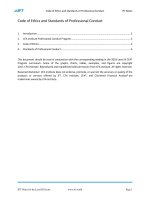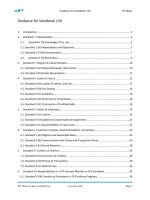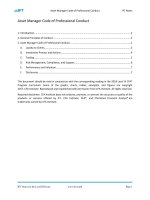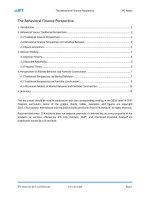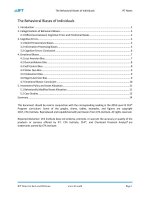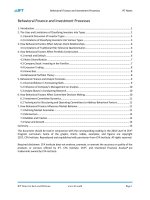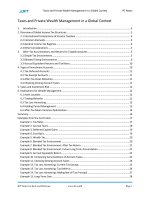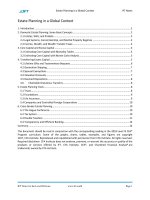CFA 2018 level 3 schweser practice exam CFA 2018 level 3 question bank CFA 2018 CFA 2018 r03 applications of code and standards IFT notes
Bạn đang xem bản rút gọn của tài liệu. Xem và tải ngay bản đầy đủ của tài liệu tại đây (398.99 KB, 9 trang )
Applications of Code and Standards
IFT Notes
Applications of Code and Standards
1. Introduction .............................................................................................................................................. 2
2. The Consultant .......................................................................................................................................... 2
3. Pearl Investment Management (A)........................................................................................................... 5
4. Pearl Investment Management (B) ........................................................................................................... 6
5. Pearl Investment Management (C) ........................................................................................................... 7
This document should be read in conjunction with the corresponding reading in the 2018 Level III CFA®
Program curriculum. Some of the graphs, charts, tables, examples, and figures are copyright
2017, CFA Institute. Reproduced and republished with permission from CFA Institute. All rights reserved.
Required disclaimer: CFA Institute does not endorse, promote, or warrant the accuracy or quality of the
products or services offered by IFT. CFA Institute, CFA®, and Chartered Financial Analyst® are
trademarks owned by CFA Institute.
IFT Notes for the Level III Exam
www.ift.world
Page 1
Applications of Code and Standards
IFT Notes
1. Introduction
This reading provides several cases to demonstrate how the CFA Institute Code of Ethics and Standards
of Professional Conduct should be applied, how to recognize violations and what corrective actions are
required to correct the violations.
Exhibit 1 provides a framework to help with the ethical decision-making process.
A framework for ethical decision making
• Identify the Important Facts and Issues
• Identify Others to Whom Duties are Owed
• Identify Potential Conflicts of Interest
• Identify Applicable Ethical Principles
• Consider Seeking Additional Guidance
• Consider Circumstances That Could Be Affecting Judgment
• Consider Alternative Actions
• Act and Review the Outcome
We will look at the application of this framework in the first case ‘The Consultant’. In the remaining
three cases we will focus on what violations occurred and what corrective action is required and what
polices need to be adopted to prevent future violations.
2. The Consultant
Case facts
Mark Vernley’s background:
This case focuses on Mark Vernley. Mark started his career several years ago as a petroleum engineer
and then he moved on to become a securities analyst focused on the energy sector. Eventually Mark
started his own consulting firm called ‘Energetics’. While he was working as a securities analyst, Mark
also became a CFA charterholder.
During his career Mark has built a substantial portfolio and most of his portfolio is in energy stocks. This
makes sense because he understands this sector well. His largest holding is in ‘Deepwell Explorations’,
where he worked for several years, he got options and those options were ultimately exercised.
The consulting contract:
Mark and his team at Energetics have been hired by ‘Highridge Oil Pipeline’ to address a significant
issue. The issue is that Highridge Oil Pipeline has a very difficult relationship with its customers. There
are contentious arguments about what the correct price should be. Mark and his team have suggested a
profit sharing solution that would work well for both Highridge and its customers.
However, Plains Pipeline Systems which is a competitor of Highridge Systems claims that the plan
presented by Mark and his team is flawed, because Mart has a conflict of interest. According to Plains
Pipeline, Mark has personal holdings in several companies which will benefit from Mark’s proposed
plan. This issue has been presented to the regulator and the regulator has decided that there is no
evidence of wrongdoing. So the ruling is in Mark's favor. However Mark is still concerned about this
IFT Notes for the Level III Exam
www.ift.world
Page 2
Applications of Code and Standards
IFT Notes
perceived conflict of interest and how this will impact his firm in the future.
Evaluation of the case using the ethical decision making framework
Identify the Important Facts and Issues: The main point in this case is that Mark Vernley who is a
professional engineer and a CFA charterholder, has been charged with having a conflict of interest. This
conflict of interest has prevented him and his company from offering objective advice to his clients, and
from presenting objective advice to the regulatory agency. Even though this claim has been rejected,
Mark is still concerned about the perceived conflict of interest, and the potential impact on him and his
company.
Identify Others to Whom Duties are owed: Mark Vernley clearly has a duty to Highridge, because
Highridge is the client. Mark might also have a duty to the regulatory agency. Mark does not have any
duty to Plains, which is a competitor of Highridge.
Identify Potential Conflicts of Interest: Mark may have a conflict of interest with Highridge because: 1)
Mark has personal holdings in oil companies serviced by Highridge and 2) the plan presented by Mark
benefits those companies. There could be a conflict of interest between Highridge and the regulator.
There is also a conflict of interest between Highridge and competitors such as Plains.
Identify Applicable Ethical Principles: From the Code and Standards we know that Mark is expected to
place client’s interest above his own. Other ethical principles addressed in the Code and Standard are
more specific to the investment profession and global capital markets.
Consider Seeking Additional Guidance: Clearly this is what Mark should do. He is thinking about what is
the appropriate course of action.
Consider Circumstances That Could Be Affecting Judgment: Mark’s holdings in oil companies might be
impacting his judgment.
Consider Alternative Actions: Broadly speaking Mark could use the following two strategies or a
combination of these two strategies: (1) avoidance and (2) disclosure
(1) Avoidance
•
•
•
Extreme case: An extreme form of avoidance would be to avoid investments in energy-related
companies. This is considered extreme, because it is not very realistic. We can’t just expect
someone to completely liquidate and sell all his interests in the sector. While it will clearly
avoid any conflict of interest this is a somewhat extreme step.
Blind trust: In this option, Mark’s energy-related investments will move into what is called a
blind trust. This trust will be managed by another fund manager, and the fund manager then
reports to Mark on a quarterly basis as required by the law. The advantage here is that Mark
only finds out about the investment decisions after they have been made and this helps reduce
the conflict of interest. However, the slight issue with this arrangement is that as long as there
are energy securities is in the trust there is still a possible perceived conflict of interest. So Mark
would have to disclose these holdings or disclose the fact that he has a blind trust which
possibly includes energy companies to clients and prospective clients.
Mutual fund: A third possible solution under the avoidance category, is to invest in a mutual
IFT Notes for the Level III Exam
www.ift.world
Page 3
Applications of Code and Standards
IFT Notes
fund which specializes in energy-related issues. This mutual fund will be managed by a third
party, and as with any mutual fund, the exposure to any one stock would be relatively low. So
from the avoidance perspective this appears to be the most logical route to take.
(2) Disclosure
•
Let's say, however, that Mark really wants to keep his stake in the various companies. Then the
next best thing to do is to disclose as much as possible. In fact at a very minimum Mark must
disclose to clients of Energetics, the existence and nature of any conflict of interest surrounding
a consulting assignment. Vernley must ensure that such disclosures are prominent and are
delivered in plain language and communicate the relevant information effectively.
A Plan for Energetics
The case leads us to believe that Mark himself is ethical and has high integrity. Also, the people who
work in his organization belong to professional organizations and act ethically. However, the
shortcoming is that there is no formal compliance program in the company. So the perception of
potential conflicts of interest can harm the company. Therefore, the plan of action for Energetics should
be to create some sort of a formal compliance system. The main areas of focus are:
Culture and leadership: Ethical values start at the top and the organization needs to develop a culture of
honesty, integrity and high ethics. To some extent that is already happening because of the informal
communications that Mark has with his team. However, Mark should develop this further.
Communication: A formal system of ethics needs to be developed. Perhaps the CFA Institute Code and
Standards could be used. Relevant parts of the engineer’s code of conduct can also be used. Then the
code for Energetics needs to be formalized and communicated with the team.
Education: The communication can happen through formal education. There should be training sessions
and workshops where all employees of energetics properly understand the compliance procedures.
Procedures for compliance
Companies should have written documents that spell out their compliance procedures. A company can
document several measures that are aids in managing its compliance program effectively, including:
• annual certification by employees that they have maintained familiarity with the standards and
agree to abide by them;
• for the purpose of detecting conflicts of interest or insider trading, required reporting by
employees, at least quarterly, of all securities transactions for their own personal accounts or
those in which they have a beneficial interest;
• disclosing to management the existence and nature of any possible or actual compensation
from sources other than the employer;
• certification by employees that they have not entered into an independent business activity in
competition with their employer. The purpose of this measure is to protect the firm from, for
example, misappropriation of trade secrets, misuse of confidential information, solicitation of
customers prior to cessation of employment, or self-dealing; and
• employee memberships in organizations that maintain standards required for the practice of
their professions—for example, continued affiliation by Energetics’ engineers with the
IFT Notes for the Level III Exam
www.ift.world
Page 4
Applications of Code and Standards
IFT Notes
association of professional engineers.
Summary
The two major points of this case are:
•
•
While the protagonist in this case, Mark Vernley, isn’t directly involved in the investment
industry, he is however a charterholder and he does projects that involve valuation, so the CFA
Institute Code and Standards apply to him. Also he is a supervisor and he therefore needs to
ensure that those working under him also follow the Codes and Standards and act ethically.
The other point is that clearly Mark Vernley is a man of high integrity, and yet that alone is not
enough. Those who follow the Code and Standards also need to formally put in place practices
and procedures to ensure that that a high level of ethics is maintained. To whatever extent
possible even a perception of misconduct should be avoided.
3. Pearl Investment Management (A)
Case Facts
The protagonist in this case is Peter Sherman who obtained an MBA and then started work as an
account manager with Pearl investment management. Pearl investment management is an investment
consulting firm, specializing in equity portfolio management for institutions as well as high net worth
individuals. Sherman begins work in the firm’s back office handling administrative tasks for his assigned
accounts, settling transactions, balancing the accounts to bank records and ensuring that client
guidelines are followed.
Pearl is a large firm with a number of different departments. Pearl also has its own research staff. Many
of the portfolio managers and analysts at Pearl are CFA charterholders and as a result the firm has
adopted the CFA Institute Code and Standards as part of its policy for internal compliance.
All employees must read and sign a statement when they join the firm that they have read Pearl’s
policies. They must repeat this procedure at the beginning of each subsequent year as a reminder of
their compliance responsibilities.
On Sherman’s first day on the job, his department head gives him the policy manual as part of his
orientation program, requests that he read it during the day before signing the compliance statement,
and advises him that the firm’s compliance department will answer any questions he may have.
Sherman reads through the manual quickly and then signs the company’s personnel policies statement.
After a few months Sherman settles in his role. He sees the close access to investment information and
strategies as an opportunity to invest his savings with greater insight. He reads books about investment,
as well as the company summaries prepared by the firm’s research department. He shares this
knowledge with family and friends. He decides to purchase few stocks that are Pearl’s largest equity
positions.
Violations
Sherman read the manual quickly and then signed the company’s policy statement. Two violations
occurred here. The supervisor simply instructed Sherman to read the manual but he did not help ensure
IFT Notes for the Level III Exam
www.ift.world
Page 5
Applications of Code and Standards
IFT Notes
that Sherman understood the document. So this is a violation of ‘Responsibilities of Supervisors’. Also,
by skimming the document, Sherman probably did not understand the laws. So this is a violation of
‘Knowledge of the Law’.
By using the firm’s proprietary information and client information for his personal investments, Sherman
has violated ‘Duties to Employer’ as well as ‘Loyalty, Prudence and Care’. The fact that Sherman’s
supervisor is not aware of this situation and has not put in polices in place to prevent this, means that
‘Responsibilities of Supervisors’ is also violated. If Sherman trades securities before trading for clients
then, ‘Priority of Transactions’ and ‘Fair Dealing’ are also violated.
Recommended Policy Statement for the firm
To prevent potential violations, the policies that the firm can put in place are:
Knowledge of the Law: “Supervisors shall exercise reasonable supervision over those employees subject
to their control and shall monitor all actions of employees in their charge to determine that the firm’s
policies are being followed and to prevent any violation by such persons of applicable statutes,
regulations, or provisions of the Code of Ethics and Standards of Professional Conduct. Supervisors shall
review the contents of the compliance manual with all direct charges when they are hired and answer
any questions or concerns the employees may have.”
Responsibilities of Supervisors: “Employees shall submit personal trades to the compliance department
for approval in advance of any personal investment action in order to clear the trades against client
transactions. In the event that an employee wishes to transact in securities that are being traded for
clients, the employee will be allowed to trade only after all client transactions have been processed, the
compliance department has approved the request, and a 24-hour moratorium has expired. On a
monthly basis, all personal trades (as shown on brokerage statements of account) must be submitted to
the compliance department for review.”
Managing confidential client information: “Proprietary information shall not be communicated outside
the firm. ‘Proprietary’ includes information about client portfolios, investment strategies, and portfolio
actions and recommendations. Furthermore, employees should be mindful of the special relationship
with Pearl’s clients and ensure that the highest degree of care is preserved when investment action is
taken on their behalf.”
4. Pearl Investment Management (B)
Case facts
One year later, Sherman prepares for and passes the Level I examination. He is assigned the task of
clearing up problems related to allocation of an IPO among certain large client accounts. Since this is
rush project, Sherman does not have time to consult the client’s investment policy statements. He
assumes that portfolio managers would have seen them and directed only those trades which were
suitable to the clients. He also believes that trading desk would have acted as a second review for client
investment guidelines. Sherman makes some adjustments, reverses a few transactions and reallocates
shares at the IPO price. He believes that in doing this, all clients have been treated fairly.
IFT Notes for the Level III Exam
www.ift.world
Page 6
Applications of Code and Standards
IFT Notes
Violations
Since allocation of trades is taking place only amongst large clients, it implies that smaller clients have
been overlooked. So there is a potential violation of ‘Fair Dealing’.
By not going through the client’s investment policy statements, Sherman has violated ‘Loyalty, Prudence
and Care’. He cannot assume that someone else (portfolio manager or trading desk) will take care of
this.
Since the misallocation was the firm’s error, the firm should bear all losses and they should not be
passed on to clients. Simply reversing the transactions is not enough. If client money was used during
this period of time, then appropriate interest should also be credited to the client accounts.
A point to note is that since Sherman has now started participating in the CFA Program, he is should
follow the Codes and Standards. In Case A he was bound only as an employee of the firm. Now he is
bound both as an employee of the firm and as a candidate in the CFA Program.
Recommended Policy Statement for the Firm
To prevent violations, the policies that the firm can adopt are:
Dealing with clients: “Employees owe a duty of loyalty, prudence, and care to clients, and in all
instances, the interests of clients shall come first. Action contrary to this policy is expressly prohibited.
Allocation of trades shall be on a fair and equitable basis for all portfolios with similar investment
objectives and constraints.”
Bearing the financial risk of errors in client accounts: “The firm will take all steps necessary to ensure the
integrity of its client accounts. When errors do occur, the clients’ portfolios will be restored with no loss
of value to the client. To the extent that such losses occur, Pearl will indemnify its clients and make the
appropriate restitution.”
5. Pearl Investment Management (C)
Case facts
Sherman has now passed Level II and gets a position in the research department. He reports to Champa
who has a lot of experience in the international markets. Champa wants the firm to start research
efforts in international equities and in particular wants to start with developing countries. He tells his
team to come up with research recommendations in emerging equities quickly.
Sherman starts his research on Central and South American companies. Champa refers Sherman to one
of his old banking contacts, Gonzalo Alves, who is well connected in Mexico and on the board of
directors of a number of important Mexican corporations. Alves tells Sherman about the strategic
direction of each company, some potential acquisition targets, and how changes in the Mexican
economy will affect each company directly. Sherman now feels comfortable using this information in
writing his research reports.
Champa asks Sherman to produce a research report on several Mexican telecommunications and cable
companies. He gives Sherman a very tight deadline. Due to shortage of time, Sherman plans to prepare
IFT Notes for the Level III Exam
www.ift.world
Page 7
Applications of Code and Standards
IFT Notes
reports quickly by using brokerage firm reports and his conversation with Alves and other sources. He
does not cite these sources because he believes they are well known.
A junior analyst asks Sherman about why his report did not include specific details about the Mexican
economy or the historical exchange rate fluctuations between the Mexican peso and the US dollar. She
questions the comparability of Mexican securities with US securities and notes that the diversification
available from investing in global markets is achieved only if the correlation between the specific non-US
market and the US market is low. Sherman and Champa respond that “our clients are sophisticated
investors; they know these things already.”
Violations:
In his discussion with Alves, Sherman gained access to material non-public information. If he uses this
information in his research, this will be a clear violation of ‘Material Non-Public Information’.
By not giving sufficient time to conduct research, ‘Diligence and Reasonable Basis’ is violated.
By not citing all sources used, ‘Misrepresentation’ is violated.
By not communicating important details about the exchange rates and correlations, ‘Communication
with Clients and Potential Clients’ is violated. Also the approach used by Sherman to prepare his
research report needs to be disclosed. The report should clearly distinguish between facts and opinions.
If the company is positing itself as an expert in emerging markets that is clearly a misrepresentation. The
appropriate action would be to disclose to clients that they are beginning to research and invest in
emerging market companies.
Recommended Policy Statement for the firm
To prevent violations, the policies that the firm can adopt are:
Proper care and independent judgement: “Analysts shall use proper care and exercise independent
professional judgment in the preparation of research reports to ensure that reports are thorough,
accurate, and include all relevant factors.”
Use of insider information: “Analysts and portfolio managers are prohibited from using material nonpublic information in any form in making investment recommendations or taking investment action. Any
employees who have come into possession of material non-public information (or who believe they
have) shall contact the compliance department or compliance officer for guidance. If the information is
determined to be material non-public information, the employee must refrain from acting on it and
should take steps to disseminate the information publicly.”
Using Research of others: “Analysts are prohibited from using the work of others without reference and
are prohibited from plagiarizing the work of others by not giving due credit to the author, whether or
not the author is employed by the firm.”
Reasonable basis for a research opinion: “All relevant factors, including the basic characteristics involved
in the investment, are to be included in a research report, with a corresponding discussion of the
potential risks involved.”
IFT Notes for the Level III Exam
www.ift.world
Page 8
Applications of Code and Standards
IFT Notes
Relevant factors and fact versus opinion in research reports: “Employees shall make only those
statements, either verbally or in writing, about the firm and its qualifications that represent the firm
properly and with the integrity it has tried to achieve. The firm shall not solicit clients, new or existing,
for a new investment style without full disclosure of the firm’s qualifications and expectations for both
risk and potential return. Performance results for a new investment style will be in compliance with
Standard III(D)—Performance Presentation, as discussed in the CFA Institute Standards of Practice
Handbook.”
IFT Notes for the Level III Exam
www.ift.world
Page 9
